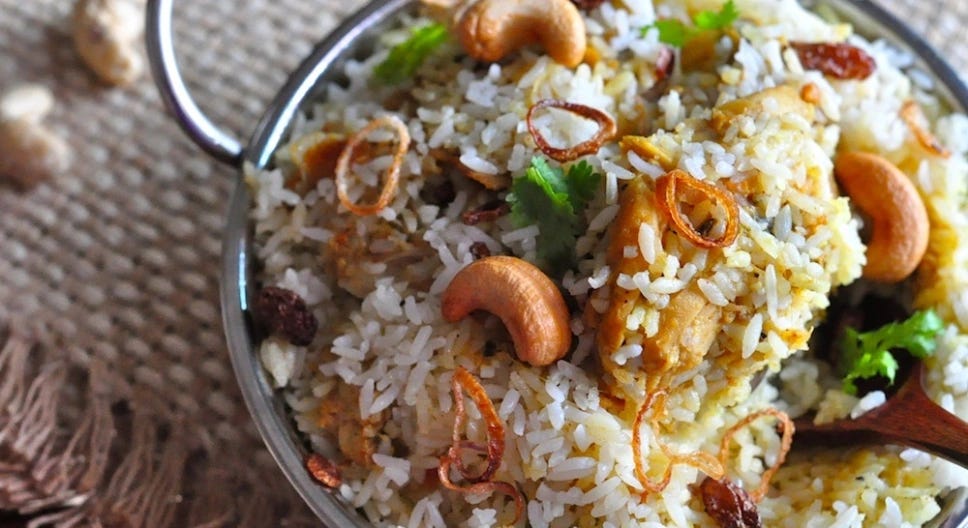The Malabari Food Scene
Mappila, also known as a Mappila Muslim, formerly anglicized
as Moplah/Mopla, in general, is a member of
the Muslim community of the same name found predominantly
in Kerala, southern India. The Mappila community originated
primarily as a result of the West Asian contacts with Kerala,
which was fundamentally based upon commerce (“the spice
trade”). As per local tradition, Islam reached the Malabar Coast, of
which the Kerala state is a part of, as early as the 7th century
AD. Before being overtaken by the Europeans in the spice
trade, Mappilas were a prosperous trading community, settled
mainly in the coastal urban centres of Kerala. The continuous
interaction of the Mappilas with the Middle East has created a
profound impact on their life, customs and culture. This has
resulted in the formation of a unique Indo-Islamic synthesis —
within the large spectrum of Kerala culture — in literature, art,
food, language, and music.
Thalassery Biriyani
The Mappila community of Kerala owes a lot to the spice trade
that had been happening in the Malabar region since 1000 BC.
The famed Tellicherry black pepper that brought seafarers from
as far as Rome changed the culinary landscape of not just the
traders who took the spices to faraway lands and introduced
pepper into the diet of Europeans, but also of the local
communities. Drawing from the Portuguese, Dutch, English and
most heavily, Arab influences, Mappila food is the best sort of
an amalgamation of local and borrowed food traditions.
The bare bones of Mappila cooking rest on the choice of spices
used in the various aanams (coconut milk-based
curries), kootans (yoghurt-based curries) and desserts. Red
chilli, cardamom and cloves take centre stage in this cuisine.
Other commonly used flavourings are ginger, curry leaves, and
coconut. Tamarind, and in some cases, green mango is used
as souring agents. Ironically enough, the Tellicherry pepper that
was so instrumental in shaping the history of Mappila cuisine,
features very rarely in the food!
The pièce de résistance of Mappila cooking is without a doubt
the Thalassery Biryani. It differs from Mughlai biryani in a few
important ways. Unlike the Mughlai variant, where the meat is
tenderized by marinating the pieces in yoghurt for several hours
(a classic Persian technique), Tellicherry biryani does not rely
on yoghurt to give the meat its characteristic fall-off-the-bone
quality. Instead, the meat gets its softness from the long hours
of being kept on dum – which involves providing heat from both
the top and bottom of the vessel.
The Arab influence is most apparent in Mappila food in terms of
certain techniques used in the preparation of the meals. For
example, ghee features widely in Mappila food, although the
rest of the communities in the region rely heavily on coconut oil.
The Arab Bedouins are also known to use ghee made from the
cattle that they rear.
Another common characteristic is the affinity for stuffed meats.
In the case of Mappila food, kozhi thalayana, a whole chicken
stuffed with boiled eggs and then encased in dough and baked
is a classic that clearly draws inspiration from various Arab
dishes like the stuffed camel, where a camel is stuffed with a
chicken which is then stuffed with a boiled egg! And like the
Arabs, the Mappilas, until quite recently, enjoyed festive meals
by sitting around in circles and sharing from a giant platter set
in the middle.
“Food is such an integral part of the lifestyle and culture of the
Malabar coast that it’s very difficult for people like us who have
grown-up here in the city to understand. One can say the
people of the Malabar live and breathe food, especially the
members of the Mappila community, which has a long-standing
the tradition of whipping up the most delicious dishes to be served
to their new sons-in-law, called the puthiyapilla. Eating is often
a family affair; not only in Muslim homes but across religions. In
fact, if you visit a home in the area, they pile the food on you
and it’s almost an offence if you refuse to eat from there,”
explains Kalesh, a city-based gastronome and food travelogue
host, who was one of the first to explore the cuisines of Kerala
on the small screen.
The recent evolution in Middle-eastern food culture has waved
the shores of Malabar too as the connection between the
region and the countries around the Persian gulf still are
connected extensively. After the discovery of oil and the economic
boom in the middle east, it has become a major opportunity for a
good number of Malabaris to find a livelihood. This grand expat
community and their rapid interaction have brought all major
ways across the Arabian sea too.
In the coming years, as more and more Malabari youth becomes
aware of their rich and peculiar gastronomic culture, the
Malabari cuisine sees a global future.




